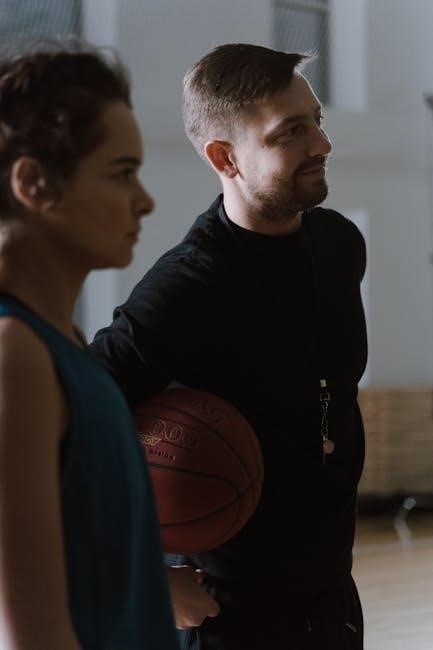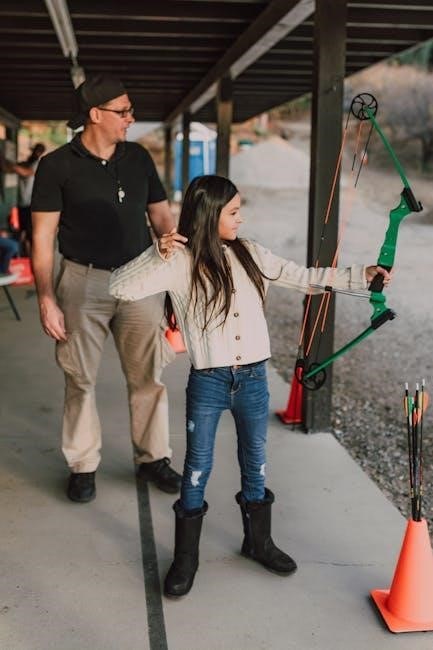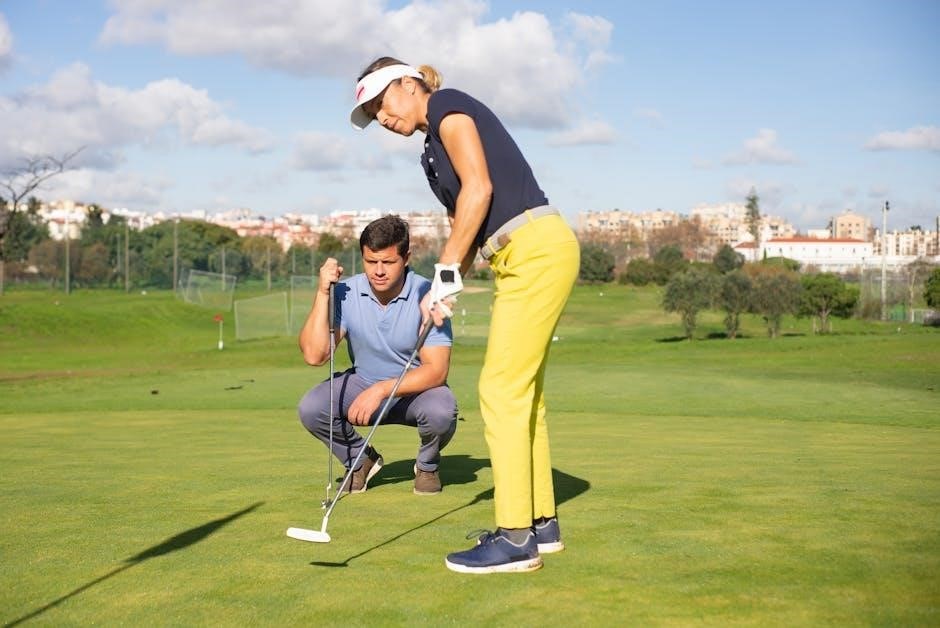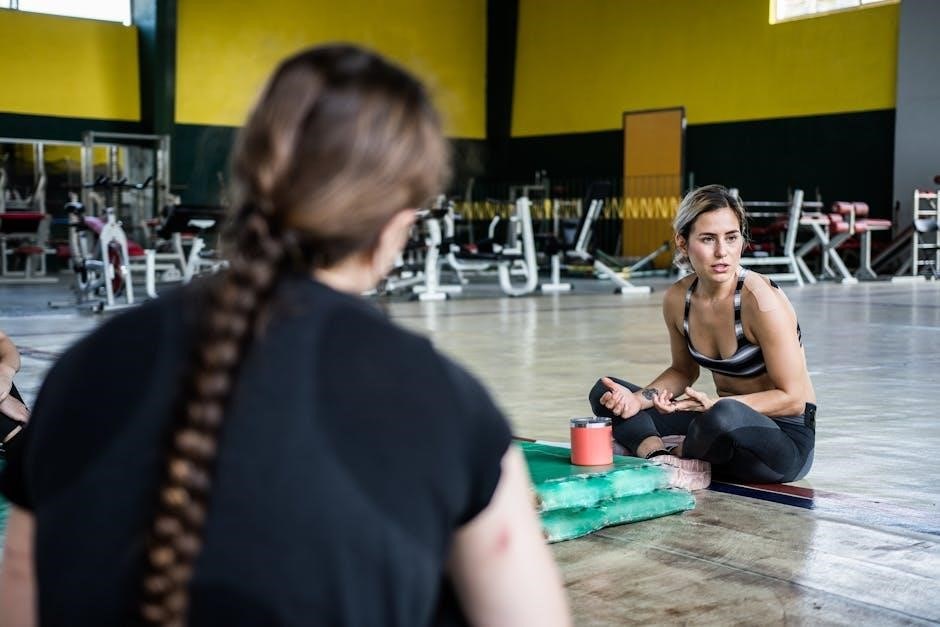Sports instruction is a dynamic field focusing on enhancing athletic performance through structured training, personalized coaching, and integration of technology․ It emphasizes skill development, safety, and mental preparation to empower athletes at all levels, fostering growth and excellence in various sports disciplines․
1․1 Definition and Scope of Sports Instruction
Sports instruction refers to the systematic process of teaching and guiding athletes to improve their performance, skills, and overall understanding of a sport․ It encompasses a wide range of activities, including training methods, personalized coaching, and the integration of technology to enhance learning․ The scope of sports instruction varies from amateur-level youth programs to professional athlete development, covering both individual and team sports․ Effective instruction ensures athletes gain not only technical proficiency but also physical conditioning, mental toughness, and tactical awareness․ Additionally, it emphasizes safety and injury prevention, making it a holistic approach to athlete development․ Sports instruction is tailored to meet the unique needs of diverse populations, ensuring inclusivity and adaptability across different skill levels and goals․
1․2 Importance of Sports Instruction in Modern Athletics
Sports instruction plays a pivotal role in modern athletics by enhancing athlete performance, preventing injuries, and fostering overall development․ It provides structured training methods and personalized feedback, enabling athletes to refine their skills and achieve specific goals․ Effective instruction also promotes mental resilience, teamwork, and strategic thinking, which are essential for success in competitive environments․ Additionally, sports instruction ensures adherence to safety protocols and proper techniques, reducing the risk of injuries and improving long-term athletic sustainability․ With the integration of technology and data-driven insights, modern sports instruction offers tailored approaches to meet the diverse needs of athletes, making it a cornerstone of athletic development in today’s fast-evolving sports landscape․

Key Components of Effective Sports Instruction
Effective sports instruction combines training methods, personalized coaching, and technology to enhance performance․ Clear communication and continuous feedback are essential for athlete development and success․
2․1 Training Methods and Techniques
Effective training methods and techniques are cornerstone of sports instruction, tailored to enhance performance and skill development․ These include strength training, plyometrics, endurance exercises, and sport-specific drills․ Coaches often incorporate periodization, dividing training into phases to optimize progress and prevent overtraining․ Technique refinement through video analysis and real-time feedback is crucial for improving athlete execution․ Additionally, mobility and flexibility exercises are integrated to enhance movement efficiency and reduce injury risk․ Technology, such as wearable devices, aids in monitoring progress and adjusting training regimens․ A balanced approach ensures athletes develop physically, technically, and tactically, preparing them for competitive demands while fostering long-term growth and resilience․
2․2 Role of Personalized Coaching Plans
Personalized coaching plans are integral to sports instruction, enabling athletes to achieve specific goals efficiently․ These plans are tailored to individual needs, considering factors like skill level, fitness, and objectives․ Coaches assess athletes’ strengths and weaknesses, creating structured regimens that address unique requirements․ Personalized plans enhance engagement and motivation, as athletes see progress aligned with their targets․ They also reduce injury risks by focusing on proper technique and gradual progression․ Incorporating feedback mechanisms ensures adaptability, allowing adjustments based on performance and changing goals․ Technology, such as wearable devices, supports data-driven decision-making, optimizing training outcomes․ Personalized coaching fosters a collaborative relationship between athlete and coach, promoting a holistic approach to development and peak performance․ This customized method is vital for maximizing potential in modern sports instruction․
2․4 Incorporating Technology in Sports Training
Technology has revolutionized sports training, offering innovative tools to enhance performance and efficiency․ Wearable devices now track metrics like heart rate, speed, and movement, providing real-time feedback․ Data analytics software processes this information to identify trends and optimize training regimens․ Virtual reality (VR) and augmented reality (AR) create immersive environments for skill simulation, enabling athletes to practice without physical strain․ AI-driven platforms analyze technique and suggest improvements, reducing injury risks․ Video analysis tools allow coaches to review and correct movements in detail; Additionally, mobile apps provide personalized workout plans and nutrition advice․ Technology not only bridges the gap between training and results but also empowers athletes and coaches to make informed decisions, fostering a more dynamic and effective approach to sports instruction․
Safety and Injury Prevention in Sports Instruction
Safety and injury prevention are critical in sports instruction, emphasizing proper warm-ups, equipment usage, and emergency response planning to protect athletes and ensure a secure training environment․
3․1 Warm-Up and Cool-Down Routines
A proper warm-up prepares the body for physical activity by increasing heart rate, muscle temperature, and flexibility, reducing the risk of injury․ It typically includes light cardio, such as jogging, and dynamic stretches․ Cool-down routines, performed after exercise, help the body transition back to a resting state, promoting relaxation and waste removal․ Both processes are essential for injury prevention, enhancing performance, and ensuring long-term athlete safety․ Incorporating these practices into sports instruction demonstrates a commitment to holistic training and athlete well-being, aligning with modern approaches to physical conditioning and health maintenance․
3․2 Proper Equipment Usage
Proper equipment usage is critical for safety and performance in sports instruction․ Using the right gear ensures athletes can execute techniques effectively while minimizing injury risks․ Coaches must emphasize correct fitting, maintenance, and adherence to safety standards․ For instance, helmets, knee pads, and shoes are tailored to specific sports to provide optimal protection․ Improper equipment can lead to poor performance or severe injuries․ Educating athletes on equipment care and selection is vital for longevity and success․ A well-equipped athlete not only performs better but also gains confidence, fostering a safer and more productive training environment․ This foundational aspect of sports instruction ensures that athletes can focus on skill development without compromising their well-being․
3․3 Emergency Response Planning
Emergency response planning is essential in sports instruction to ensure prompt and effective action during injuries or unforeseen incidents․ A well-structured plan includes first aid protocols, communication strategies, and evacuation procedures․ Coaches and staff must be trained to handle emergencies, such as cardiac arrests or concussions, to minimize risks and provide immediate care․ Regular drills and updates to the plan help maintain preparedness․ Clear communication channels and accessible emergency equipment are critical components․ Additionally, educating athletes on basic first aid and emergency procedures enhances overall safety․ A comprehensive emergency response plan not only protects participants but also builds trust and confidence in the sports instruction program, ensuring a safer environment for all involved․
Sports Instruction for Specific Populations
Sports instruction must be tailored to meet the needs of diverse groups, including youth, seniors, and individuals with disabilities․ Programs should emphasize age-appropriate training, adaptive techniques, and inclusivity to ensure safe and effective participation for all athletes, fostering growth and engagement regardless of ability or age․
4․1 Youth Sports Instruction Programs
Youth sports instruction programs are designed to foster physical, emotional, and social development in young athletes․ These programs emphasize age-appropriate training methods, focusing on skill acquisition, teamwork, and sportsmanship․ Safety is a priority, with proper warm-up routines, equipment usage, and injury prevention strategies․ Coaches often incorporate fun and engaging activities to maintain motivation and build a lifelong love for sports․ Additionally, these programs aim to enhance cognitive abilities through structured drills and problem-solving exercises․ By providing a supportive environment, youth sports instruction helps children develop confidence, discipline, and essential life skills․ Regular feedback and positive reinforcement are key to nurturing their growth and potential․

4․2 Senior and Adaptive Sports Instruction
Senior and adaptive sports instruction caters to individuals with unique needs, ensuring accessibility and inclusivity․ Programs for seniors focus on maintaining mobility, strength, and cardiovascular health through low-impact exercises tailored to age-related physical changes․ Adaptive sports instruction adapts activities for individuals with disabilities, using specialized equipment and techniques to promote participation and empowerment․ Both programs emphasize safety, proper equipment usage, and modified routines to accommodate physical limitations․ Trained instructors create supportive environments that foster confidence, social interaction, and overall well-being․ These programs not only enhance physical fitness but also contribute to mental health by providing opportunities for engagement and achievement․ They highlight the importance of sports instruction for diverse populations, ensuring everyone can benefit from physical activity regardless of age or ability․

The Role of Mental Preparation in Sports Instruction
Mental preparation in sports instruction enhances athletes’ mindset, focus, and confidence, enabling them to perform optimally under pressure and achieve their goals consistently through structured techniques․

5․1 Mindset Development and Goal Setting
Mindset development and goal setting are foundational to sports instruction, fostering resilience, focus, and motivation․ Athletes learn to cultivate a growth mindset, embracing challenges as opportunities for improvement․ Coaches guide them in setting SMART (Specific, Measurable, Achievable, Relevant, Time-bound) goals, enhancing clarity and direction․ This process boosts confidence and maintains consistency in training․ Visualization techniques and positive self-talk are also integrated to strengthen mental fortitude․ By aligning mindset development with realistic objectives, athletes achieve peak performance and sustain long-term success in their sports journeys․
5․2 Visualization Techniques for Athletes
Visualization is a powerful tool in sports instruction, enabling athletes to mentally rehearse performances and build confidence․ By imagining specific actions or outcomes, athletes enhance focus, motor skills, and emotional resilience․ Techniques involve vivid mental imagery, often paired with relaxation methods, to simulate game scenarios or perfect movements․ This practice strengthens neural pathways, improving muscle memory and reaction times․ Coaches encourage athletes to visualize success, overcoming challenges, and handling pressure, fostering a competitive edge․ Regular visualization sessions can also reduce anxiety and enhance performance consistency, making it a vital component of modern athletic training programs․
Sports instruction is a comprehensive and evolving field that plays a crucial role in shaping athletic success․ By combining effective training methods, personalized coaching, and mental preparation, it empowers athletes to reach their full potential․ The integration of technology and a focus on safety further enhance the quality of instruction, ensuring athletes perform at their best while minimizing risks․ As the sports landscape continues to evolve, the role of skilled instructors and innovative techniques will remain vital in fostering excellence and adaptability among athletes․
Ultimately, sports instruction is not just about physical skill development but also about building resilience, mindset, and a lifelong passion for sports․ Its impact extends beyond the field, contributing to personal growth and societal well-being․
